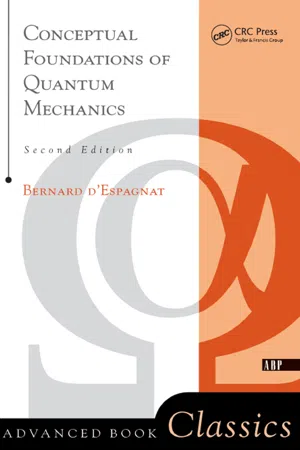
This is a test
- 348 pages
- English
- ePUB (mobile friendly)
- Available on iOS & Android
eBook - ePub
Book details
Book preview
Table of contents
Citations
About This Book
Conceptual Foundations of Quantum Mechanics provides a detailed view of the conceptual foundations and problems of quantum physics, and a clear and comprehensive account of the fundamental physical implications of the quantum formalism. This book deals with nonseparability, hidden variable theories, measurement theories and several related problems. Mathematical arguments are presented with an emphasis on simple but adequately representative cases. The conclusion incorporates a description of a set of relationships and concepts that could compose a legitimate view of the world.
Frequently asked questions
At the moment all of our mobile-responsive ePub books are available to download via the app. Most of our PDFs are also available to download and we're working on making the final remaining ones downloadable now. Learn more here.
Both plans give you full access to the library and all of Perlego’s features. The only differences are the price and subscription period: With the annual plan you’ll save around 30% compared to 12 months on the monthly plan.
We are an online textbook subscription service, where you can get access to an entire online library for less than the price of a single book per month. With over 1 million books across 1000+ topics, we’ve got you covered! Learn more here.
Look out for the read-aloud symbol on your next book to see if you can listen to it. The read-aloud tool reads text aloud for you, highlighting the text as it is being read. You can pause it, speed it up and slow it down. Learn more here.
Yes, you can access Conceptual Foundations Of Quantum Mechanics by Bernard D'espagnat in PDF and/or ePUB format, as well as other popular books in Physical Sciences & Physics. We have over one million books available in our catalogue for you to explore.

Conceptual Foundations of Quantum Mechanics
Second Edition
PART ONE
ELEMENTS OF QUANTUM MECHANICS
The formalism of quantum mechanics was introduced some 50 years ago. Since then it has been successfully used to account for an extraordinarily large number of newly discovered phenomena. As a matter of fact, it has become a universal tool in physics. Even the theoretical descriptions that deal with the elementary particles are based on its fundamental principles. This is a remarkable fact indeed, since the energies involved are some billion times larger than those that characterize the domain of atomic physics, in which quantum mechanics was born.
As a counterpart to this universality, some of the basic ideas of quantum mechanics bear no relation whatsoever to the concepts used in our daily life. As such they are worth investigating, and our program is indeed to do so. However, before we engage ourselves in this enterprise, we must remember that simple basic experiments are at the origin of all these surprising notions. Therefore Chapter 1 and 2, which are introductory, briefly recall how the quantum formalism could be abstracted from some crucial experimental facts. The principles of quantum mechanics are then formulated (Chapters 3, 4, and 5). Since quantum mechanics is a coherent, self-contained formalism from which a vast number of consequences and predictions of different kinds can be deduced, it appears pertinent to formulate these principles in an axiomatic way, that is, as a set of rules whose ultimate justification lies in the agreement of its predictions with the results of physical observations.
The problem of trying to understand what physical interpretation can be given to these rules is the main subject of this book. It is a highly nontrivial one. It should not be confused with the simpler and more immediate problem of stating precisely what these rules are, independently of any interpretation that should, or could, be given them. In Chapter 3, 4 and 5 the principles are simply formulated as a set of rules that make it possible to predict—in a statistical way at least—the results of future observations from a knowledge of the results of past observations on physical systems. It should be stressed that this method of exposition does not imply a preference for a particular interpretation or a particular epistemology. It is, rather, a provisional step: we must first state precisely (independently, if possible, of any assumption and with economy of words and symbols) a set of rules that lead to experimentally verified predictions for observed phenomena. Later (but only later) we will assume that it is interesting to try to construct from these rules a real description of the physical world; for example, we can try to reformulate the rules in a language not involving the concept of an observer. The decision as to whether such a reformulation is desirable (assuming that it is possible) is essentially, in the view of many, a philosophical option; for this reason it is preferable to defer it to later chapters.
Finally, it is important to note the following fact: some of the most significant principles to which a detailed analysis of the foundations of quantum mechanics leads are in fact more general than is suggested by the manner in which they were obtained. Indeed, they also follow from just a few very qualitative ideas plus the results of some rec...
Table of contents
- Cover
- Half Title
- Title Page
- Copyright Page
- Table of Contents
- PEDRO’S DEBATE (PREFACE TO SECOND EDITION)
- PREFACE TO FIRST EDITION
- Part One ELEMENTS OF QUANTUM MECHANICS
- Part Two DENSITY MATRICES AND MIXTURES
- Part Three QUANTUM NONSEPARABILITY
- Part Four MEASUREMENT THEORIES
- Part Five KNOWLEDGE AND THE PHYSICAL WORLD
- Part Six SUMMARY AND OUTLOOK
- AUTHOR INDEX
- SUBJECT INDEX